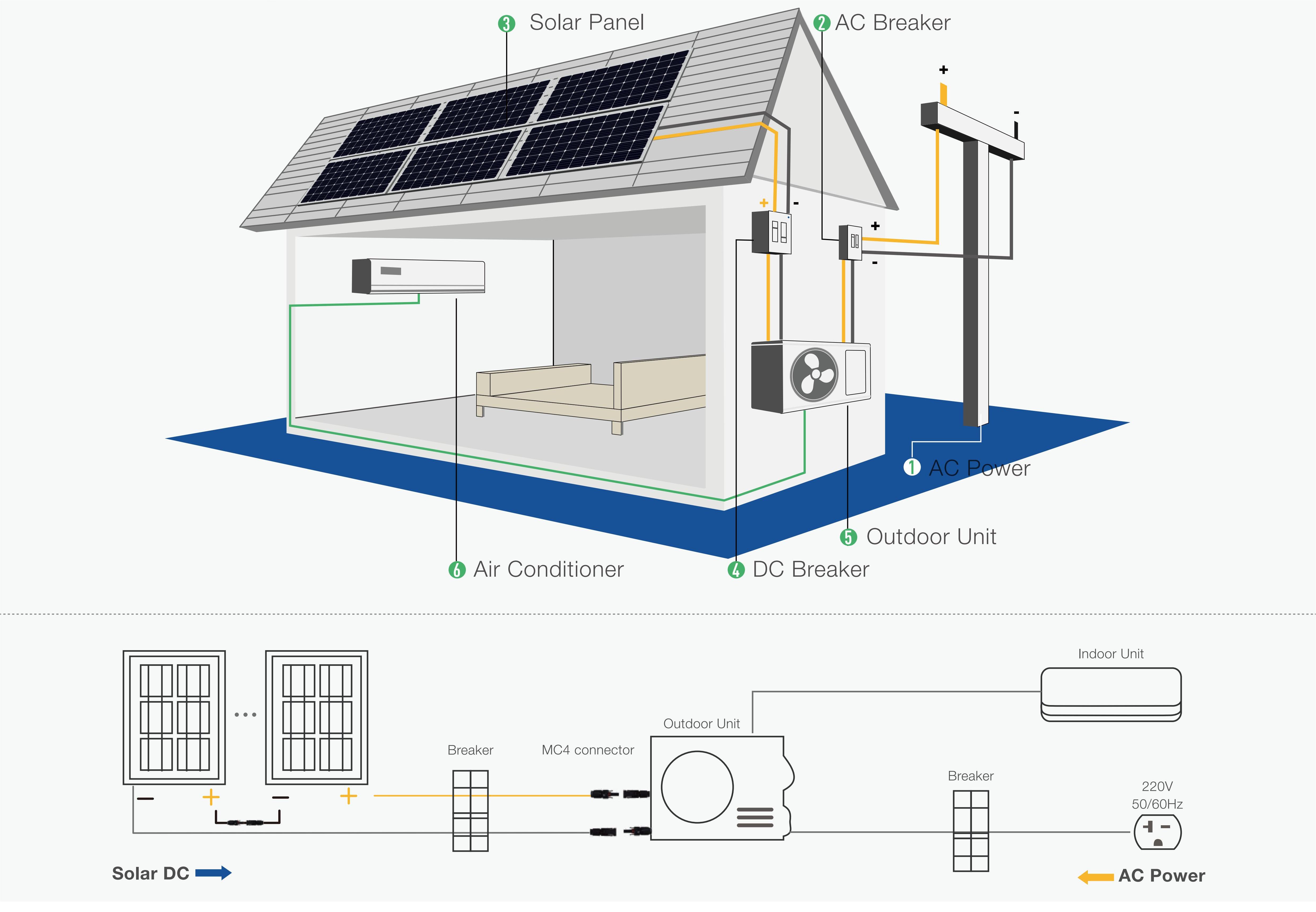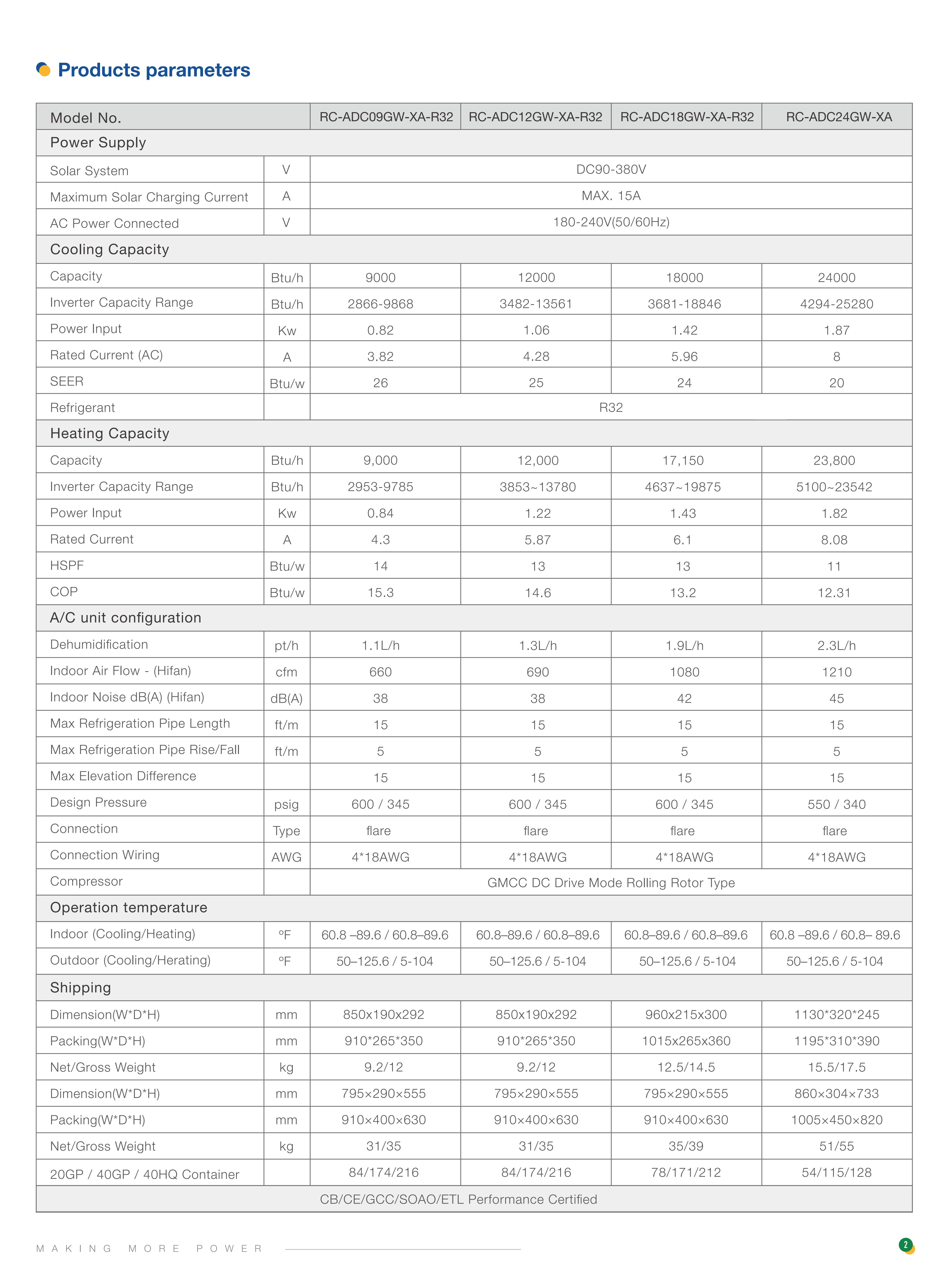A solar air conditioner is designed to operate using solar energy, typically generated by photovoltaic (PV) panels. The efficiency of a solar air conditioner refers to how effectively it converts solar energy into cooling power. The efficiency of a solar air conditioner can vary depending on factors such as the quality of the system, the size and efficiency of the PV panels, the type of cooling technology used, and the environmental conditions.
Solar panel voltage:
DC90-380VMaximum Solar Charging Current:
15AAC Power Connected:
180-240V(50/60Hz)Refrigerant:
R32Compressor:
GMCC DC Drive Mode Rolling Rotor TypeConnection:
Flare
Generally, solar air conditioners are more efficient than traditional air conditioners when it comes to energy consumption. Since they rely on renewable solar energy, they can help reduce electricity costs and are considered environmentally friendly. The specific efficiency of a solar air conditioner can be measured in terms of the solar energy utilization ratio, which indicates how effectively it converts solar energy into useful cooling output.
When considering a solar air conditioner, it is important to choose reliable and reputable manufacturers and suppliers. Look for products with good user reviews and warranty support. The warranty offered for a solar air conditioner can vary depending on the manufacturer, but it typically covers defects in materials and workmanship for a certain period, such as 5 or 10 years.
It is recommended to thoroughly research and consult with experts or professionals when considering the purchase of a solar air conditioner. They can provide more accurate information about the efficiency and warranty guarantees specific to the available models in the market.

solar air conditioner working way
A solar air conditioner, also known as a PV (photovoltaic) powered air conditioner, operates by utilizing solar energy to power its cooling system. Here is an overview of how it works:
Solar panels: The system consists of solar panels, often installed on the roof or an open area with maximum exposure to sunlight. These panels contain photovoltaic cells that convert sunlight into electricity.
Electricity generation: When sunlight hits the solar panels, the photovoltaic cells generate direct current (DC) electricity. The panels are typically connected in an array to produce the desired amount of electricity.
Power conversion: The DC electricity from the solar panels is sent to an inverter, which converts it into alternating current (AC) electricity. AC power is the standard type of electricity used in most homes and appliances.
Air conditioner unit: The AC electricity is then used to power the air conditioner unit. The unit consists of components such as a compressor, condenser, expansion valve, and evaporator, which work together to cool the air.
Cooling process: The air conditioner's compressor pressurizes a refrigerant gas, typically a hydrofluorocarbon (HFC) or hydrochlorofluorocarbon (HCFC), creating a high-temperature, high-pressure gas.
Heat exchange: The hot gas then flows into the condenser, where it releases heat to the surrounding environment. This step transfers the heat from inside the room to the outside.
Expansion and evaporation: The refrigerant, now in a cooler state, passes through an expansion valve, which reduces its pressure. This causes the refrigerant to expand and evaporate, absorbing heat from the indoor air.
Indoor cooling: The cool evaporated refrigerant flows through the evaporator coil, where it collects heat from the room, thereby cooling the air. The cooled air is then circulated back into the indoor space through ducts or fans.
Cycle repetition: The refrigerant, now in a gaseous state, returns to the compressor, and the cycle repeats to maintain the desired cooling effect.

The advantage of a solar air conditioner is that it reduces the dependence on traditional electricity sources and can significantly lower energy costs. Moreover, by utilizing renewable solar energy, it has a reduced environmental impact compared to traditional air conditioning systems. However, the actual performance and efficiency of a solar air conditioner can vary based on factors such as solar panel capacity, climate conditions, and system design.
home use solar air conditioner
A solar air conditioner is a type of air conditioning system that utilizes solar energy to power its operation. It operates in a similar way to a traditional air conditioner, but instead of relying solely on electrical power from the grid, it harnesses solar energy to reduce its energy consumption and environmental impact.
Here's a general overview of how a typical home solar air conditioner works:
Solar Panels: The system consists of solar panels installed on the roof or any suitable location where they can receive maximum sunlight. These solar panels convert sunlight into electrical energy using photovoltaic (PV) cells.
Energy Conversion: The electrical energy generated by the solar panels is converted from direct current (DC) to alternating current (AC) using an inverter. AC is the standard form of electricity used in most homes and appliances.
FAQs:
Q1: Do you support OEM/ODM?
A:Definitely, OEM&ODM service is supported with a certain quantity,including customize logo,package and label;
Q2: What's the production time?
A: The production time is normally 15 working days. but we will always prepare some stocks for popular models.
Q3: Can you provide DDP service?
A:Yes, if you are a personal customer and don't want to deal with the customs, we can provide DDP service to your address.
Q4: What about the warranty and how to claim?
A: Warranty period are 5 years since you receive the product, our professional after-sales team will deal with all warranty issues.